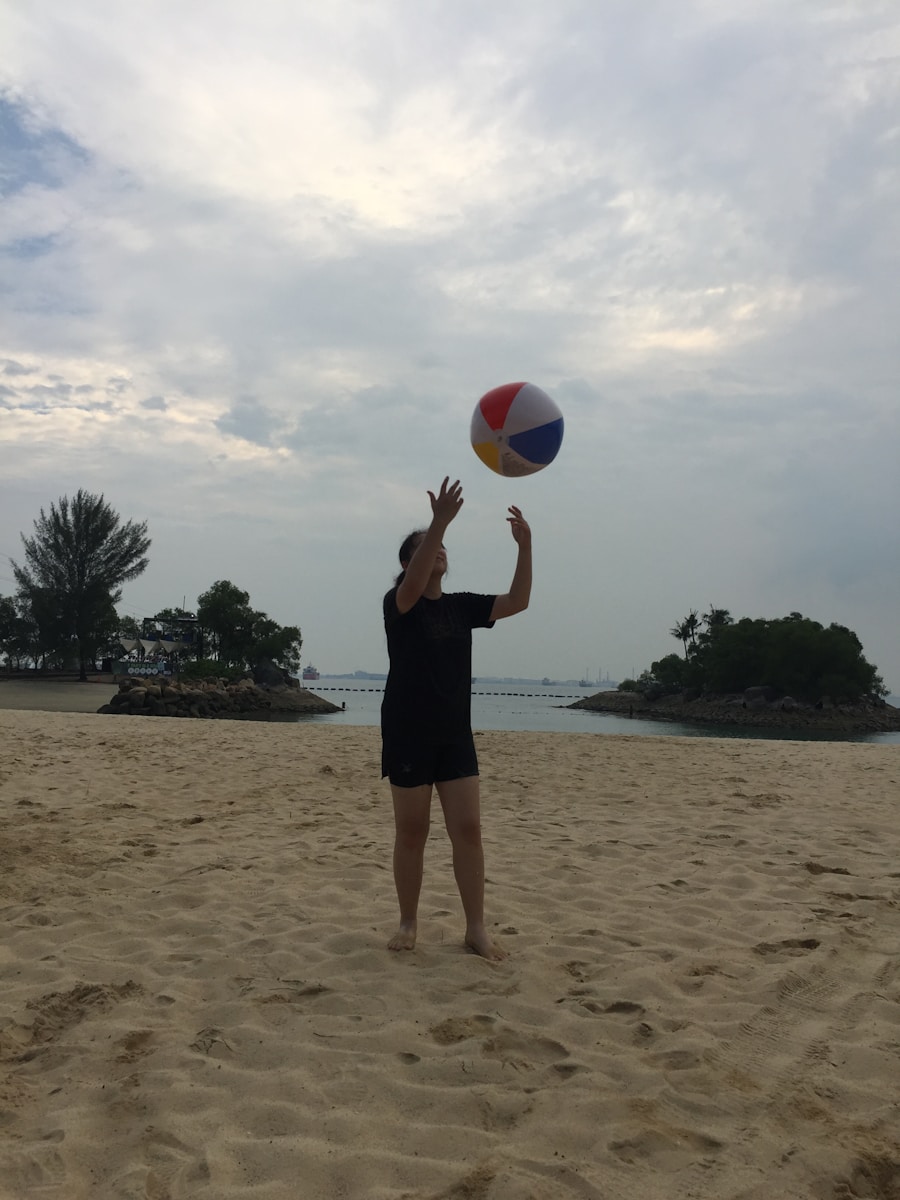Download links
How to install Mastering the Art of Volleyball: Tips for Success APK?
1. Tap the downloaded Mastering the Art of Volleyball: Tips for Success APK file.
2. Touch install.
3. Follow the steps on the screen.
Description
Volleyball is a dynamic sport that combines elements of strategy, agility, and teamwork. Originating in the United States in 1895, it has evolved into a globally recognized game played on various surfaces, including indoor courts, beaches, and grass. The fundamental objective of volleyball is to score points by sending the ball over a net and into the opponent’s court, while simultaneously preventing the opposing team from doing the same.
Each match is played in sets, with teams typically consisting of six players on the court at any given time. The game is characterized by its fast pace and the need for quick decision-making, making it essential for players to have a solid understanding of the rules and basic skills. At its core, volleyball is governed by a set of rules that dictate how the game is played.
Each team is allowed three touches to return the ball over the net, which usually involves a combination of passing, setting, and hitting. The net height varies between men’s and women’s competitions, with men’s nets set at 2.43 meters and women’s at 2.24 meters. Players must also be aware of their positions on the court, as rotations and substitutions are integral to maintaining team dynamics.
Understanding these basics not only helps players perform better but also fosters a deeper appreciation for the sport itself.
Key Takeaways
- Volleyball is a team sport played with six players on each side, aiming to score points by grounding the ball on the opponent’s court.
- To improve serving technique, focus on consistent toss, proper hand placement, and a fluid arm swing to generate power and accuracy.
- Master passing and setting by maintaining a low and wide base, using the platform for passing, and setting with soft hands and precise location.
- Develop hitting and blocking skills by practicing approach footwork, timing the jump, and penetrating the net with strong hands and good body positioning.
- Enhance defensive abilities by staying low and ready, reading the hitter’s body language, and reacting quickly to dig or receive the ball.
- Mental preparation and team communication are crucial for success in volleyball, requiring focus, positive mindset, and effective communication with teammates for coordinated play.
Improving Your Serving Technique
Serving is one of the most critical skills in volleyball, as it initiates each rally and can set the tone for the entire match. A well-executed serve can put pressure on the opposing team, forcing them into a defensive position right from the start. There are several types of serves that players can master, including the underhand serve, overhand serve, and jump serve.
Each type has its own advantages and requires different techniques to execute effectively. For instance, the underhand serve is often used by beginners due to its simplicity, while the jump serve can be a powerful weapon in an experienced player’s arsenal. To improve serving technique, players should focus on their stance, grip, and follow-through.
A solid stance involves positioning the feet shoulder-width apart for balance, with one foot slightly in front of the other. The grip on the ball should be firm yet relaxed, allowing for a smooth release during the serve. Practicing the toss is also crucial; it should be consistent and high enough to give players ample time to strike the ball at its peak.
Additionally, incorporating drills that emphasize accuracy and power can significantly enhance serving skills. For example, targeting specific zones on the court during practice can help players develop precision in their serves.
Mastering the Art of Passing and Setting

Passing and setting are fundamental skills that form the backbone of effective volleyball play. Passing, often referred to as “digging” or “receiving,” involves accurately receiving serves or attacks from opponents and delivering the ball to a setter. A successful pass requires proper body positioning, footwork, and hand-eye coordination.
Players should aim to create a stable platform with their forearms when passing, ensuring that they direct the ball toward their intended target with precision. Setting is equally crucial as it determines how effectively a team can execute its offensive plays. A setter’s role is to deliver accurate sets to hitters, allowing them to attack the ball effectively.
To master setting, players must develop a keen sense of timing and spatial awareness. The hands should be positioned above the forehead with fingers spread wide to create a “window” for the ball. Practicing different types of sets—such as high sets for outside hitters or quick sets for middle blockers—can enhance a setter’s versatility.
Additionally, communication with teammates is vital; setters must be aware of their hitters’ preferences and tendencies to deliver optimal sets.
Developing Effective Hitting and Blocking Skills
| Metrics | Value |
|---|---|
| Success Rate of Hitting | 75% |
| Blocking Efficiency | 80% |
| Number of Hitting Errors | 10 |
| Number of Blocks | 25 |
Hitting and blocking are two of the most exciting aspects of volleyball, showcasing athleticism and strategy in equal measure.
To become an effective hitter, players must focus on their approach, timing, and follow-through.
The approach typically consists of three or four steps that build momentum before jumping to strike the ball at its highest point. Proper footwork is essential; players should practice their approach regularly to develop muscle memory. Blocking complements hitting by providing a defensive strategy against opposing attacks.
A successful block requires timing, positioning, and coordination among teammates. Players must read the hitter’s body language to anticipate their attack and jump at the right moment to intercept the ball. Effective blocking also involves using proper hand positioning—hands should be open and fingers spread wide to create a larger surface area for deflecting the ball back into the opponent’s court.
Drills that simulate game situations can help players refine their blocking skills while fostering teamwork and communication.
Enhancing Your Defensive Abilities
Defense in volleyball is often overlooked but is crucial for a team’s success. A strong defensive strategy can turn the tide of a match by preventing opponents from scoring while creating opportunities for counterattacks.
Digging involves receiving hard-driven balls from opponents using proper body mechanics to absorb impact while maintaining control over the ball. Positioning is equally important in defense; players must anticipate where attacks are likely to come from based on their opponents’ tendencies and formations. This requires keen observation and quick reflexes.
Defensive specialists often practice reading hitters’ movements and adjusting their positions accordingly to maximize their chances of making successful digs or passes. Additionally, incorporating drills that focus on reaction time and agility can significantly enhance defensive capabilities.
Mental Preparation and Team Communication

While physical skills are essential in volleyball, mental preparation plays an equally vital role in achieving success on the court. Players must cultivate a strong mindset that allows them to remain focused under pressure and adapt to changing game situations. Visualization techniques can be beneficial; athletes often use mental imagery to envision successful plays or strategies before executing them during matches.
This practice not only boosts confidence but also helps players mentally rehearse their roles within the team. Team communication is another critical aspect of mental preparation in volleyball. Effective communication fosters trust among teammates and ensures that everyone is on the same page during matches.
Players should develop clear signals for plays, rotations, and defensive strategies to minimize confusion during high-pressure situations. Regular team meetings or huddles can facilitate open discussions about strategies and individual roles within the team dynamic. By prioritizing both mental preparation and communication, teams can enhance their overall performance and cohesion on the court.
In summary, mastering volleyball requires a comprehensive understanding of its fundamentals while continuously improving specific skills such as serving, passing, hitting, blocking, defense, mental preparation, and communication within a team context. Each aspect contributes to a player’s overall effectiveness and enhances their ability to contribute positively to their team’s success in this fast-paced sport.
If you’re a fan of volleyball and enjoy the thrill of competition, you may be interested in learning more about how to increase your chances of winning big with Taya365 Lottery. In a recent article titled “Taya365 Lottery: Cara Mudah Menang Jackpot”, the author discusses easy strategies to improve your odds of hitting the jackpot. By following these tips, you could potentially walk away with a significant cash prize while enjoying your favorite sport.
FAQs
What is volleyball?
Volleyball is a team sport in which two teams of six players are separated by a net. The objective is to score points by grounding the ball on the opposing team’s court.
What are the basic rules of volleyball?
The basic rules of volleyball include serving the ball over the net, rallying to keep the ball in play, and trying to score points by grounding the ball on the opposing team’s court. Each team is allowed three touches to return the ball over the net.
What are the different types of volleyball games?
There are several different types of volleyball games, including indoor volleyball, beach volleyball, and sitting volleyball. Each type has its own specific rules and variations.
What are the key skills needed to play volleyball?
Key skills needed to play volleyball include serving, passing, setting, attacking, blocking, and digging. Players also need good communication and teamwork skills.
What is the history of volleyball?
Volleyball was invented in 1895 by William G. Morgan, a YMCA physical education director, in Massachusetts, USA. It was originally called “mintonette” and was designed as a less strenuous alternative to basketball.
What are the dimensions of a volleyball court?
A standard volleyball court is 18 meters long and 9 meters wide, with a net in the middle. The net is set at a height of 2.43 meters for men’s games and 2.24 meters for women’s games.
What are the different positions in volleyball?
The different positions in volleyball include setter, outside hitter, opposite hitter, middle blocker, libero, and defensive specialist. Each position has specific roles and responsibilities on the court.
What are the main volleyball tournaments and events?
The main volleyball tournaments and events include the Olympic Games, FIVB World Championships, FIVB World Cup, FIVB World Grand Prix, and various continental and regional championships.





